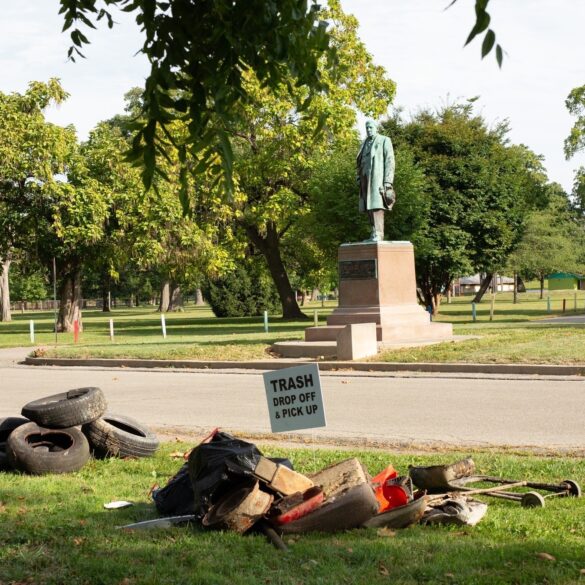The White River is one of Indiana’s most significant environmental landmarks, flowing through central Indiana and linking communities across the region, according to the White River Report Card. However, despite mainly flowing through Indiana, the White River impacts water that lies far beyond the state, Superintendent of Sanitation and Recycling for the Muncie Sanitary District Jason Donati says.
“The White River Watershed covers a lot of area… It actually starts in Randolph County in a farm field, and Muncie is the first large city that it goes through. Then it drains to the Wabash, and then to the Ohio, and from the Ohio into the Mississippi River, and then the Mississippi into the Gulf of Mexico,” Jason says.
For Jason, protecting pieces of the environment like the White River is more than just a job — it’s a lifelong passion.
“I served in AmeriCorps, which is a domestic Peace Corps in the United States, where I got to learn a lot about community projects, environmental projects, and how to organize [the protection of] the environment and cleanups,” Jason says.
After moving back to Muncie, he applied his knowledge from AmeriCorps on environmental sustainability to create programs through the Muncie Sanitation District. One of his most notable efforts is the White River Cleanup initiative.
“I helped bring together the White River Cleanup Steering Committee with members of Muncie-Delaware Clean & Beautiful, and we plan the cleanup every year to help pick up litter and trash in the White River and keep it clean,” Jason says.
Clean & Beautiful, a local nonprofit organization, has a strong connection to Ball State University. According to their website, the organization focuses on beautifying the community through litter removal, environmental education, and community engagement. Its president, Dr. Melinda Messineo, is a sociology professor at Ball State University.
“Our partnerships are key to making it successful, and we’re grateful and thankful for all of them,” Jason says.
To clean the river, teams are organized to walk along its banks while canoe teams paddle upstream to reach and clean the deepest areas of the river. Community outreach, especially with younger generations, is a key focus for the Muncie Sanitation District. Jason recognizes that environmental education plays a significant role in this effort.
According to the National Environmental Education Foundation, such education promotes active learning, citizenship, and student leadership, empowering youth to make a positive impact in their communities. These educational and engagement efforts not only resonate with youth but also influence the habits of the adults in their lives.
“We love it when youth volunteer with us because it’s something that they’ll never forget and something that they’ll continue to do, and then teach even to their families as they get older. So visiting schools and teaching youth about being stewards is very important, and it has a high success rate,” says Jason.
Before the White River gained recognition and efforts were made to keep pollution away from its banks, it was common to see the White River run green, brown, yellow, or red from additions of untreated industrial waste and raw sewage, according to the Muncie Sanitary District.
That changed when Ball State alumnus John M. Craddock chose to conduct field research instead of writing a traditional research paper, which would eventually set the stage for environmental awareness and action in his community.
In the late 1960s, John’s early field research on the White River focused on analyzing water quality and studying the state of its organisms. His findings would soon capture media attention when he spoke at Ball State University during the first Earth Day, raising concerns about the river’s deteriorating condition and the urgent need for action.
“I didn’t realize it at the time, but it ended up meaning a lot to me. It allowed me to get the Bureau of Water Quality started and to be its director for 31 years at the time,” John says.
After the media spotlighted his research, the community began asking why nothing was being done to protect the White River. In March 1972, John was appointed director of the Division of Water Quality, which later became the Bureau of Water Quality. Under his leadership, the department took a holistic approach to improving water quality, making Muncie the first municipality at the time to adopt such a strategy.
“We went above and beyond that. Instead of just sampling the discharge from the wastewater treatment plant going to the river or sampling the industrial discharges into the wastewater treatment plant, we also sampled any discharges going directly to the river,” John says.
The Bureau of Water Quality faced the challenge of reducing industrial discharge while maintaining a foundation for urban development in the community. To address this, the Bureau formed a committee dedicated to monitoring industrial waste from local industries, ensuring both environmental protection and sustainable growth.
The water quality of the White River and the health of the organisms that call it home have vastly improved over the past 31 years, John says. Today, the river stands as a cherished highlight of the community, reflecting the dedication and efforts put into its restoration and preservation.
“We have a very healthy strain still working on a few combination sewer problems, but generally speaking, we have had a very good cleanup, a very good reduction of toxic waste,” John says
Contact Dillon Rosenlieb via email at dillon.rosenlieb@bsu.edu.
Sources: White River Report Card, Muncie-Delaware Clean & Beautiful, National Environmental Education Foundation, Muncie Sanitary District




